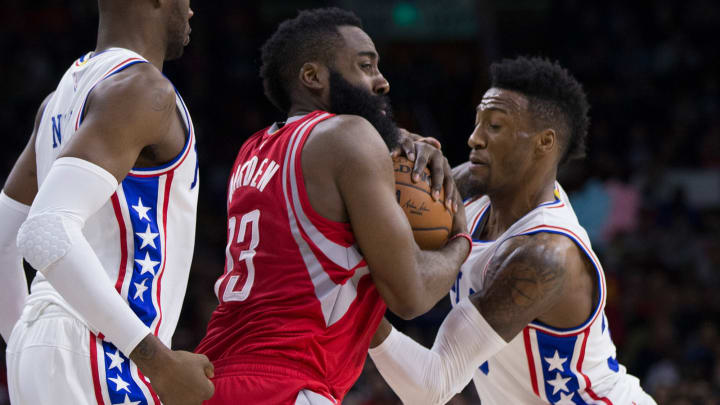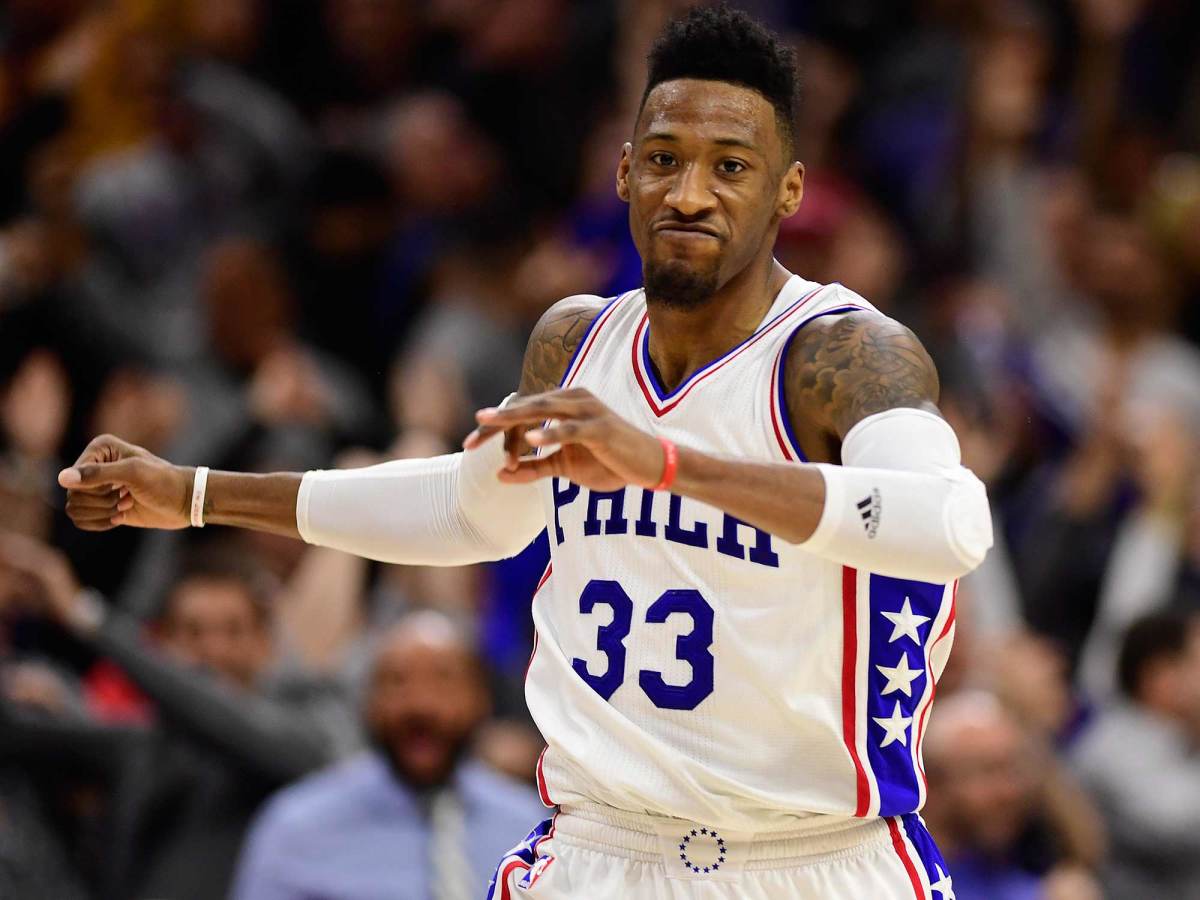Robert Covington: From One-Trick Pony To Two-Way Clydesdale

In the early 1900s, the Philadelphia neighborhood of Northern Liberties filled with artisan immigrants. The area thrived on manufacturing, blending foreign cultures through dexterous trades. Leather tanneries and iron and stove foundries formed its foundation. It berthed a collage of architecture, where its Federal-style, Greek revival and Italianate buildings are still preserved, and today Robert Covington makes his home.
It’s an ideal location for the Philadelphia 76ers swingman, suddenly the team’s longest tenured player in terms of on-court availability. Northern Liberties sits on the western edge of the Delaware River, an equidistant, 15-minute drive from both the Wells Fargo Center and the Sixers’ sprawling new practice facility on the Camden, N.J. Waterfront. Inside Covington’s residence sits a surprisingly prized possession. His DVR comes to life at 2 a.m., waking in the dead of the night to record the rebroadcast of Covington’s latest bout.
The fourth-year forward has become his own biggest critic. Covington scours the archived tape the morning after each home game, sometimes even returning home to immediately watch a specific sequence still bouncing in his brain. The Sixers coaching staff also loads footage from each contest onto the 26-year-old’s iPad. While most teammates digest movies and binge watch Netflix on flights, Covington often analyzes the film from the team’s previous contest against their upcoming opponent.
The iPad is seemingly in perpetual presentation, streaming video at the hotel, on the team bus and in the pregame locker room. By the time Covington actually takes the court, he already holds the answers to the test, having memorized his next matchup’s tendencies: when he appears to lax and offer the slightest opportunity to poke at the ball, the choreographed moves from specific locations on the floor, the disadvantageous shots you can coax him into hoisting. “You see how things transpire in previous games,” Covington explained. “And then if things look familiar, it’s all about a trigger.”
Film study has served as the main ingredient for shaping Covington into one of the NBA’s elite wing defenders. He ranks second in the league in deflections, fourth in the NBA in steals, fifth amongst small forwards in blocks per game, and 16th overall in the defensive field–goal percentage. “He came in just sort of as a spray-it-up, catch-shot, long-ball three guy,” said Sixers head coach Brett Brown. “And he helped us coach him to being a two-way-player, that elusive two-way player. And now he’s for real.”
The Sixers signed Covington to a multi-year contract in November 2014, plucking him out of the D-League to serve as a hired assassin for an 0–9 club. It took eight more games for Philly to notch its first victory of that season, when Covington scored 17 points on 3-of-6 shooting from deep, allowing the Sixers coaching staff to privately believe the team would not have won a game that season before the sharpshooter’s arrival. In the modern NBA, opposing defenses had been suffocating the Sixers’ offense devoid of a legitimate outside threat. Philadelphia only scored 93.5 points per 100 possessions during that pre-Covington stretch, which would have stood to the sixth-worst offense in NBA history.
All-Bullseye Team: Who Faces The Most Playoff Pressure?
Covington launched 8.5 threes per game in the Rio Grande Valley Vipers’ pop-a-shot system during the 2013-14 season. Within a machine designed to hoist a greater quantity than quality of outside jumpers, Covington developed a shot selection that left the Sixers’ staff scratching its heads. “That was a carnival, just jacking threes. The whole thing was based on shoot 60 threes and it’s a science project,” Brown said. “And so he came in here and started, like, you’d sort of squint and say, really?”

Brown sought to morph Covington’s skillset from a gambit into an artillery. As with all young shooters, Philly’s development staff tutored him in parlaying the threat of his jumper into an off-the-dribble attack. Yet Brown wanted to dig deeper and uncover a rarer player, an attempt to maximize the Sixers’ rebuilding program as a vacuum for organic growth. A longtime Spurs assistant, Brown wanted to construct Covington in the mold of Bruce Bowen 2.0. “When you look at his length and you go up and you just hit him, he’s long, he’s strong, he’s hard and he’s wiry,” Brown said. “You add that all up, and halfway through [2015-16] you could see he was starting to truly get it and more importantly buy into it.”
Covington regrouped with his off–season trainers in Nashville this past summer. Prior to the 2013 draft, the 6’9" forward teamed with cousins Spencer and Jamal Richardson of the aptly named All Around Game basketball academy, and the Richardsons devised a workout regimen to complete Covington’s defensive evolution. Jamal created a series of tennis-ball drills to bolster reactionary speed and instincts as well as hand-eye coordination.
Someone Tell The Knicks About Tanking, Please
They increased Covington’s foot speed with myriad ladder drills—shifting his flatted-footed form to exploding off the balls of his feet—and improved his conditioning in order to chase the NBA’s elite wing scorers for 30 minutes a night. Those methods were coupled with hours of film study, where Covington developed his addiction to video breakdowns that has turned him into a nocturnal analyst. Richardson pinpointed Covington’s strengths and weaknesses as a defender, and then the two of them evaluated hours of footage on every NBA team’s lead perimeter scorers. One week would focus on premier point guards, the next honed in on elite wings. Covington stockpiled a rolodex of cheat codes. “It’s pretty tough to break them down, because they’re so versatile, but we found little small chinks in their iron when they catch the ball in certain positions and figured out what it is they like to do on this spot,” Richardson said.
Covington has continued that collaborative tape study with Sixers assistant coach Lloyd Pierce. Before each game, Covington and Pierce go through a private film session, analyzing the tendencies of each perimeter opponent Covington is tasked with defending that evening. “I know I’m a guard different people throughout the game, so you gotta know whoever’s in front of you,” Covington said. “You can’t sit up there and guess on things.” On back-to-back nights in November, his primary assignments were John Wall and Andrew Wiggins. The former undrafted one-trick pony had grown into a two–way Clydesdale.
“Bruce Bowen would guard LaMarcus Aldridge down to [Allen Iverson] to [Carmelo Anthony] and so on—Dirk [Nowitzki]—he just was like a band-aid,” Brown said. “Robert for me, for us, is that.”

Brown and Pierce have developed an “effort chart” to measure their players’ defensive impact beyond the box score stats and even more advanced than the hustle data SportVU cameras can track. A subset of basketball operations staffers logs a series of wonky categories. They track if Sixers players walk, jog, or run during their first three steps back on defense; players’ success rates on contesting opponents’ shots; dividing the half-court into three segments, the staff pinpoints players’ appropriate positioning within the team scheme; the cohort checks if players keep their man out of the paint or prevent them from driving towards the middle of the floor. “They count a lot of stuff,” Nik Stauskas joked. It’s all compiled in a letter-graded, weekly, report card.
Covington is typically assessed an A. The Sixers hope to make double-digit deflections in each quarter, tallying one by one during the rapid pace of play. And then at the end of each frame, the staff counts each individual player’s effort numbers, frequently to discover Covington has been credited for seven or eight of the team’s 12 or so deflections—he averages 4.2 per game. “It’s all about a read,” he said.
It’s like watching a game of Whack-A-Mole as Covington poises an arm for the opportune moment to smack an opponent’s handle free.
With the dearth of legitimate two–way NBA wings, Covington will sit in an enviable position when he enters unrestricted free agency in 2018. “He will be rewarded,” Brown smiled. He applied his trade and perfected his craft on a minimum contract, sprouting from tattered roots like many in Philadelphia before him.
